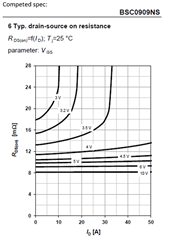Other Parts Discussed in Thread: CSD17578Q5A, CSD17578Q3A, CSD17581Q5A, CSD17576Q5B
Hi Team
There good new that we could DIN our CSD17308Q3,
And need you support following requirement to make sure DWIN ,THX
- Please help provide Rdson VS Drain current curve with CSD17308Q3
- Please help provide comparison with BSC0909NS and provide application suggestion and notice.


